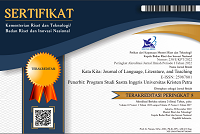Reflections on Confucianism in Four Women Characters in The Sword and The Brocade
(1) Petra Christian University
(*) Corresponding Author
Abstract
Chinese dramas, in recent years, have gained popularity in the international market. To be precise, historical dramas have a market that has increased year by year since 2017. This thesis is about Confucian virtues found in four women characters in a historical Chinese drama titled The Sword and The Brocade. This television drama intrigues the writer to analyze four women characters Luo Shi Yi Niang, Qiao Lian Fang, Madam Xu, and Xiang Yi Zhen in the story because The Sword and The Brocade shows the dynamic relationship between the women characters and the plot is wrapped in historical settings but with modern perspective. This thesis aims to find out how the female characters’ actions reflect Confucian virtues and what the impacts of the reflected actions are for them. The analysis is based on Confucianism; focusing on five Confucian virtues: loyalty, filial piety, wisdom, benevolence, and harmony. Moreover, the analysis begins with the women’s way to express the Confucian virtues within their actions and then moves to how the actions from reflecting the virtues impacted their life. From expressing loyalty to harmony, Luo Shi Yi Niang, Qiao Lian Fang, Madam Xu, and Xiang Yi Zhen get positive changes in their lives like getting a new status, achieving their goals, making their family proud, and getting positive aftermath from their past actions. The finding is these women prove that women can gain benefits from Confucianism that is known to be patriarchal and these women are the example of how ancient belief can be modernized to suit nowadays’ modern issues and the story is suitable for everyone and in every era.
Keywords
Full Text:
PDFReferences
Gert, B. (2013). Loyalty and morality. Nomos, 54, 3-21.
Guo, Q., Cui, T., Junping, L., & Ying, X. (2012). The values of Confucian benevolence and the universality of the Confucian way of extending love. Frontiers of Philosophy in China, 7(1), 20-54. http://www.jstor.org/stable/44259370
Hwang, K. K. (1999). Filial piety and loyalty: Two types of social identification in Confucianism. Asian Journal of Social Psychology, 2(1), 163-183.
Keane, M. (2005). Television drama in China: Remaking the market. Media International Australia, 115(1), 82-93.
Keane, M. (2008). From national preoccupation to overseas aspiration. TV drama in China (pp. 145-156).
Li, C. (2006). The Confucian ideal of harmony. Philosophy East and West, 56(4), 583–603. http://www.jstor.org/stable/4488054
Mack, L. (2020, Aug 28). Filial piety: An important Chinese Cultural Value. ThoughtCo. https://www.thoughtco.com/filial-piety-in-chinese-688386
Stocker, B. D. (2017). Historical fiction: Towards a definition. Journal of Historical Fictions, 1(2), 65-80.
Xu, Wei. (2020, July 4). Chinese productions attract global fanbase. Shine. Retrieved September 3, 2021 from https://www.shine.cn/feature/entertainment/2007041400/
DOI: https://doi.org/10.9744/katakita.10.3.557-563
Refbacks
- There are currently no refbacks.
Supported by:
Indexed in:
Tools:
Stats (installed since 17 December 2018)
View My Stats













